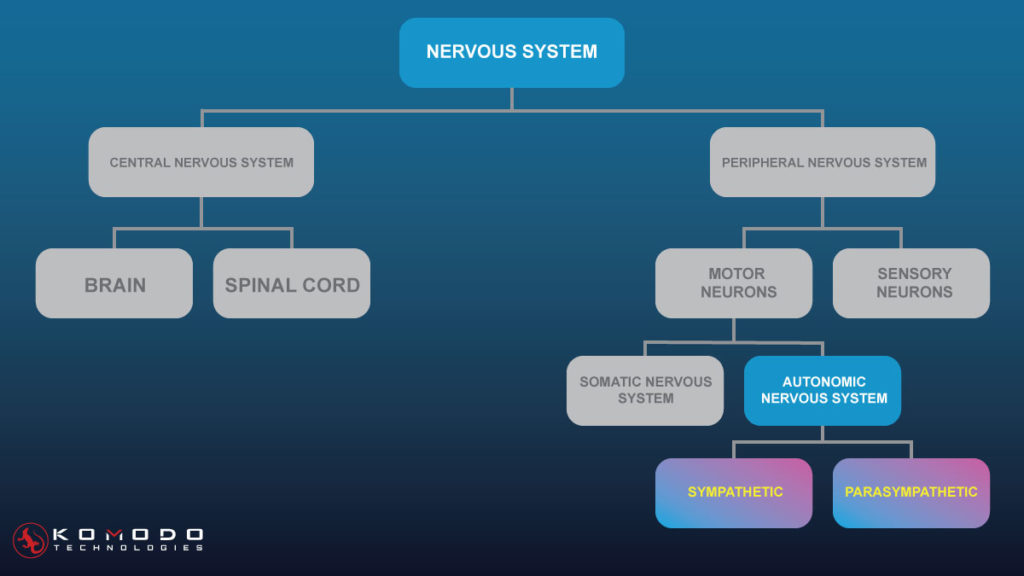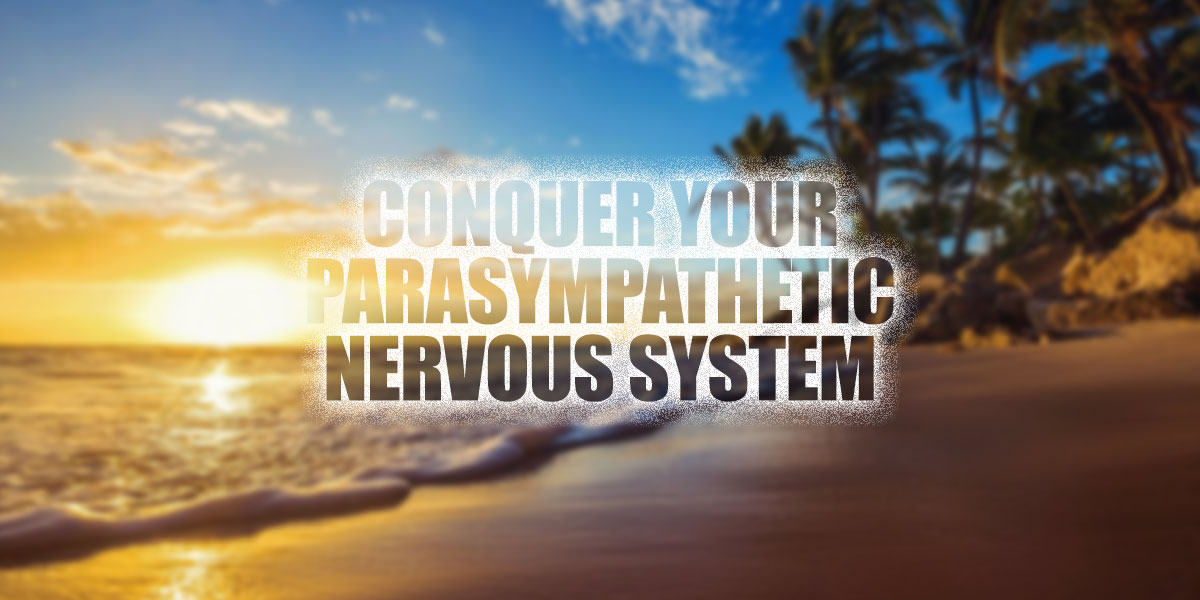The human body is by far the most interesting and complex ecosystem system to be created. It’s made up of millions of interdependent parts working together to achieve some kind of homeostasis, or balance. Some parts are more important than others. And there is no doubt that the parasympathetic nervous system (PSN) is most crucial to mastering your health, your life and your success. In this article, we will discuss how it works and talk about the importance of stimulation of the parasympathetic nervous system.
The parasympathetic nervous system is referred to as the rest-and-digest response, and it makes up one half of the autonomic nervous system (ANS). The ANS controls all involuntary actions within your body. This includes things like digestion, blood pressure, sweat, respiratory rate as well as other internal stressors on your body.
FUNCTION OF THE AUTONOMIC NERVOUS SYSTEM

The function of the autonomic nervous system is essentially to protect you. According to most experts, almost all bodily functions are regulated by the autonomic nervous system. The flip side of the parasympathetic nervous system is the sympathetic nervous system (SNS). Its commonly referred to as fight-or-flight. This system prepares you for high stress situations.
If you’re about to give a big presentation in front of hundreds of people, your fight-or-flight is activated. Your pupils dilate, heart rate is increased and focus is intensified. On the other hand, the PNS helps you recover, calm down and reduce your stress level. This is why stimulation of the parasympathetic nervous system is so crucial.
IT’S ALL ABOUT STRESS
The autonomic nervous system is all about the relationship between the brain and the rest of your body. Specifically, how your brain uniquely determines and processes stress and what affect that has on other organs, nerves and muscles. There are millions of stressors out there and each individual will have different ones. Every stressor passes through your brain (via the Vagus nerves), the brain then responds and sends the appropriate message to the rest of your body.
For example, when you are working out, your body loses oxygen. The brain is sending the signal to send oxygen to depleted muscles during a workout. This all happens in the background. However, it results in increased breath rate and heart rate in order to restore these muscles. The same explanation can be given for many other types of bodily stress.
INTERNAL STRESSORS
The best way to think about bodily stressors is to divide them into 2 categories; physical stressors and mental stressors. Physical stressors occur naturally (for lack of a better term) in your body. They stem from daily operation of your body and general upkeep. Mental stressors stem from the brain (your thoughts, perceptions, etc.)
Common Physical Stressors:
- Digestion
- Exercise
- Physical injury
- Allergies
- Aches and pains
Common Mental Stressors
- Public speaking
- Confrontation
- Anxiety from work
- Career
- Being overwhelmed
- Financial insecurity
- Body image
- Relationships
- Fear of spiders
STIMULATION OF THE PARASYMPATHETIC NERVOUS SYSTEM
Now while the physical stressors are a bit more difficult to control, the mental stressors can be (with lots of work). This is where stimulation of the parasympathetic nervous system comes in to play. Parasympathetic activation is crucial for handling stress preventing serious chronic conditions. One study shows how an over-active sympathetic nervous system (high stress) leads to diminished inhibitory control. Inhibitory control refers to automatic urges and every-day life operation and reaction time.
Chronic stress has also been associated with several types of cancer. Read here.
Controlling stress is easier said than done, but it is do-able. Yogis have been able to master their emotional health in various ways but it can take years. Here are some things you can do to aid in the stimulation of the parasympathetic nervous system.
BREATHING EXERCISES
One study conducted out of India of 25 individuals showed that daily, 15-minute breathing exercises actually improved parasympathetic activity in just 6 weeks. The way they tested PNS activity is by using heart rate variability (HRV), one of the only stress level and autonomic nervous system indicators we have today. A high HRV value is good. And in 6 weeks, each individual saw an increased HRV value just from conducting alternate nostril breathing for 15 minutes a day.
It’s quite fascinating, but not at all surprising. Deep breathing through the diaphragm has many positive health outcomes. There’s more oxygen flowing within your body, you have a tendency to relax and wipe the stress away in that moment. And if done long term, as in the study, you learn to control yourself in high stress situations. If you have access to an HRV monitor, simply record HRV with normal breathing and then again but with deep breathing. The results are phenomenal.
NITRIC OXIDE
Nitric oxide is a molecule that is produced in your body. It can also be found in food and supplements. It’s function is to open up pathways internally to allow easy blood flow to all parts of your body. Increased blood flow Is good for everything; the heart and other organs, muscle recovery, etc.
While this isn’t direct parasympathetic stimulation, it can help avoid further damage. Under stress, your breathing constricts and all processes of your body deteriorate (this includes the flow of blood). An example of over active sympathetic nervous system is high blood pressure, whereas nitric oxide has shown to lower blood pressure.
Nitric oxide can be found in vegetables like spinach, celery and lettuce as well as within antioxidants like vitamin C. it’s really not hard to find, and as we’ll discuss next, a good diet never harmed anyone.
DIET
Since digestion is a physical stressor, diet is obviously plays a big role in balancing stress. If you are constantly eating unhealthy food, it puts and unnecessary on your internal organs. Think of a car that’s not well taken care of. It has old, black oil, sludge built up, etc. That will affect everything else in the care including the engine and transmission.
HOW DOES STRESS AFFECT YOUR DIGESTIVE SYSTEM?
The same is true for your body. If you eat McDonalds every day, your are putting your body in a torture chamber. It’s using resources unnecessarily, which means your body is always pre occupied with digesting crap food. This isn’t only true of fast food but even other food that might not agree with you personally. Some people are lactose intolerant, others have nut allergies, and some don’t even know. Using an HRV monitor can help you out different levels of stress your body is going through after certain foods.
MINDFULNESS
This practice is most difficult but also the most beneficial. It’s about conquering the mind-body connection. Often with stress, when it rains, it pours and most people get easily overwhelmed. Work deadlines, paying bills, girlfriends, boyfriends, etc. we’re all going through it at all times. But those who can control stress and control those emotions are better off in the long run.
In simple terms, you need to trick your brain into thinking ‘everything’s fine’, ‘one thing at a time’, or any other proverb you associate with. Your brain doesn’t really know what’s actually causing the stress, it simply knows you’re under stress and continues to do what’s necessary.
Whether you are having a bad day at work or had an encounter with a bear, your brain doesn’t know the difference when it gets to work. So if you get stressed over the little things every day, it’s like you’re having that bear encounter every single day (according to your brain). Stimulation of the parasympathetic nervous system is difficult, but the more you work on it, the more times stressful situation becomes less so. You end up healthier, thinking clearly, and your body is operating smoothly.
TOOLS TO HELP
Here are a few tools that might help you on journey to a stress-free life
WEARABLE TECHNOLOGY
In the past 5 years, wearable technology products have taken over. The growth of the industry is unprecedented and the products are more advanced than ever before. In particular, heart rate variability (HRV) is a biomarker that has become very popular. Monitoring HRV daily can have tremendous benefits.
HRV is typically recorded over several minutes and the higher the score, the better. You can measure HRV throughout the day, in between meals, after work, in the morning, to understand which points of the day your HRV is low. Now you’re equipped with the data to make changes in your daily life. Whether that’s diet, more exercise, or more sleep, having an HRV monitor is priceless.
Products like the AIO Smart Sleeve are making it even easier for all consumers to monitor heart rate variability with an easy-to-use app and great price.
VAGUS NERVE STIMULATION
There are some products and procedures out there that can manually stimulate the vagus nerve in order to activate the parasympathetic nervous system. This is done when someone is dealing with chronic stress and/or other serious conditions. Experts have issues with disrupting the natural processes of your body. Much like prescription (and other) drugs, and alcohol; once you become dependent on something to reduce stress, your body will crave it because it helps. As opposed to fighting it and building that resilience from within.

